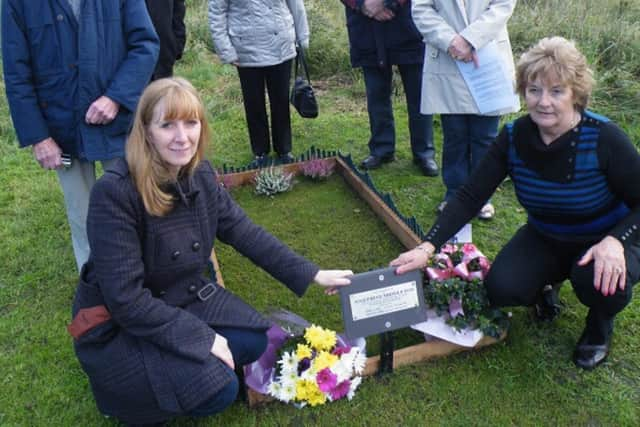Queensland woman fighting to give 'dignity in death' to Calderstones Hospital patients buried in forgotten cemetery
and live on Freeview channel 276
Mrs Sandra McArdle, originally from Liverpool but now living in Queensland, was moved by our recent article about the former Calderstones cemetery where her aunt Josephine Middleton is buried along with around 1,000 former patients and babies.
When Calderstones Hospital was built in 1915 it had its own private three-acre cemetery, one third of which was to become the Queen Mary's Military Hospital cemetery in which 33 service personnel are buried.
Advertisement
Hide AdAdvertisement
Hide AdThe remaining two thirds of the site is the Calderstones Hospital cemetery, in which at least 1,172 former patients and staff members are buried or have had their ashes interred. It is this larger section of the overall cemetery, which the Friends of Calderstones Cemetery are seeking to protect.


‘Appaling state’
Sandra said: “When I went home to see where my aunt was buried after much research to find her I met a lady called Mel Diack who lived in Whalley and was also interested in the cemetery, its appalling state and concern for the 1,000 patients and babies buried there, plus the fact the land had been sold to private developers.
“I too was appalled at the state of the cemetery, massively overgrown and the headstones sold off as pavers, so we had no way of knowing where the gravesites were or no way to identify the patients.
“We finally found the spot where Josephine was buried, grave plot 597, in one grave with two other patients. Josephine was 10 years-old when she entered Calderstones in 1926, suffering encephalitis of the brain, today they treat it with antibiotics. She spent 22 years in Calderstones and died there in 1948, aged 32 years.”
Advertisement
Hide AdAdvertisement
Hide AdMoved by the plight of the patients, in life and in death, Sandra set about trying to help the Friends in their campaign, even when returning to the other side of the world.
She wrote to senior MP Michael Gove and former senior civil servant, Sir Richard Heaton who was the Permanent Secretary to the Ministry of Justice and Clerk of the Crown in Chancery in a bid to raise awareness.
‘National disgrace’
Sandra added: “Unbelievably, there are no records. Apparently after eight years they were destroyed and only little pieces went on to Lancashire Archives. Local friends of Mel cleared the gravesite and I came home again and we had a little ceremony at her gravesite, in her memory.
“When I returned to Australia, I did more research and found the cemetery to be consecrated ground. I wrote to Minister Michael Gove and Richard Heaton, which then brought the consecrated ground to the attention of the Archbishop, who later made the decision the land could not be built on.
Advertisement
Hide AdAdvertisement
Hide Ad“Over the years, I have been back and Mel and I have kept in touch, always trying to keep this special resting place for patients and babies, who were dealt a cruel hand in life only to then be dealt this appalling situation of construction maybe being built over them.
“It is incomprehensible to think these poor souls cannot be left in peace. A national disgrace in my opinion.”
Commonwealth graves
The adjoining Queen Mary's Military Hospital cemetery is completely separate and managed by the Commonwealth Graves Commission.
It is conspicuously well maintained and cared for, which is all the more poignant when it cannot be accessed without passing through the abandoned and overgrown field in which, with all their gravestones removed, are hidden the 1,172 bodies of the hospital patients, all of whom died after the service personnel, and for some, nearly 70 years later.
Advertisement
Hide AdAdvertisement
Hide AdThe Friends of Calderstones Cemetery were formed in 2006 with the objective of trying to protect and safeguard the graves of the former patients and staff of the Calderstones Hospital who had been buried or had their ashes interred in the hospital’s own cemetery, officially between 1920 and 1989 but possibly also a little later.
History
From 1920 until 2000 the cemetery was managed and maintained as part of the Calderstones Hospital estate. Gardeners were employed to maintain all the hospital grounds, including the cemetery which was well cared for. The gardeners were also involved as grave diggers in the burial and interment of the deceased, and it is believed that the Head Gardener created his own map identifying the location of all the graves, including the 211 urns in the Garden of Remembrance.
Other maps have been found but not the Head Gardener’s. Around 1968, the then Head Gardener, Roger Hirst, and his gardeners erected and inscribed most of the 600 gravestones in the cemetery. The stone, which was sourced by the Hospital, was Portland stone, chosen to match that used by the Commonwealth War Graves Commission for the 33 service personnel in the adjoining QMMH cemetery.
Since the sale of the cemetery in 2000, it has been sold, purchased and managed by a series of different owners and companies. It is believed that at the time of the sale in 2000 it was the expressed intention of the NHS to safeguard the graves and the cemetery's long term future.
Advertisement
Hide AdAdvertisement
Hide AdUnfortunately, very shortly after its sale, all 600 plus gravestones were removed, supposedly for health and safety reasons. The same owners who oversaw the removal of the gravestones planned to open a ‘new’ private cemetery. This was officially opened in the summer of 2002, but by November 2004 the cemetery was believed to have been purchased by a mystery buyer.
For more information there is a Calderstones Cemetery website https://calderstones-cemetery.co.uk or listen to the Podcast on Whalley Local History.